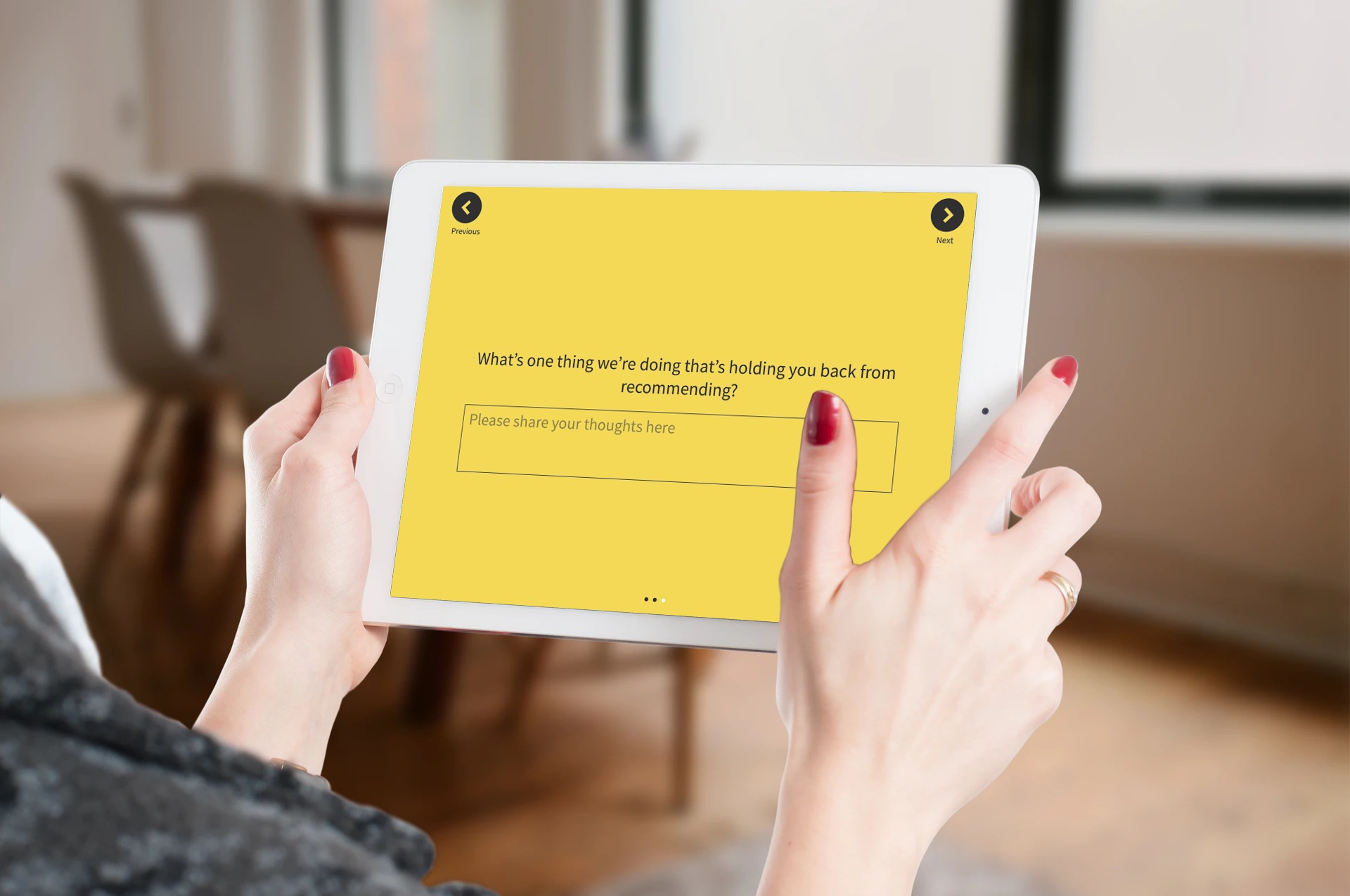If you're here, I'd assume that you already have an ongoing marketing strategy in place, which is not giving you the desired results. And it's not just you; thousands of companies out there are trying to capture the market and win customer loyalty.
The reason for the failure may vary from a lack of budget to relying on a single channel or poor customer experience. While most companies manage to overcome internal barriers by boosting their marketing budget, hiring new talents, setting clear goals, and expanding their approach to multiple channels, they somehow forget about their customers.
Customer satisfaction is the sole driver of every successful marketing strategy. Capturing customer feedback especially helps product-driven companies in closing customer feedback loop and adapting to a more customer-centric approach.
Take Action and Close the Feedback Loop👩💻
Analyze feedback, view insights, collaborate with you team and close the feedback loop to prevent churn with Zonka Feedback.

Introduction to Marketing Feedback Loops
Feedback loops have been in existence for a while now, but marketers have recently started acknowledging their value. They not only help teams to have a collaborative approach towards providing an improved customer experience but they also encourage shared accountability within the team, thus improving performance and agility. Companies that incorporate a customer-centric approach are 60% more profitable than those that don’t.
What is a Feedback Loop?
The feedback loop is a term used to describe the practice of gathering feedback from customers or internal teams to get insights on improving the product. It’s called a feedback loop because it is a continuous process aimed at making improvements to the product/service and making it more customer-centric.Marketing Feedback Loops offer a window into declining customer engagement and their perception of your brand. When you collect customer feedback (whether positive or negative), what matters is how you act on it.
Importance of Marketing Feedback Loops
There's a reason why companies invest so heavily in customer retention as for most industries, the customer retention rate is below 20%. For starters, acquiring new customers is 5-25 times more expensive for a company than retaining the existing ones. That's why it becomes a necessity to design customer experiences and success programs that support the effort of keeping the current customers satisfied and engaged with your brand.
But there's another crucial aspect that most companies miss out on - Effective Customer Feedback Management. A lot of companies, even the big ones, make the mistake of handling feedback in the most unprofitable way.
1. First, they respond to every feedback with the message - Thank you for your feedback.
2. Secondly, they only focus on the most negative responses and miss out on retaining happy customers or those customers who are on the edge of unsurity.
To minimize the churn rate, companies must not make their customers feel unvalued. While negative feedback can be worked upon, positive feedback can be rewarded or acknowledged to retain loyalty.
For example, if your company is doing a survey among the app users and the majority of the responses indicate that the app crashes a lot. You can send an email or a message to show that you will prioritize the feedback during the product development stage.
Addressing the issue can make your customers feel valued and keep them excited for any future improvements. Doing so can also create a meaningful closed feedback loop.
Four Crucial Stages of Marketing Feedback Loops
The Marketing feedback loops have four crucial stages that any marketer should know:
1. Data Collection
As the name suggests, feedback collection is the initial stage of any marketing feedback loops. There are plenty of ways to gather such data, including free surveys, live chat, social media, emails, etc.
Speaking of surveys, they are the most common method for data collection. Surveys allow companies to scale out a topic into multiple questions (both open-ended and close-ended). Surveys are a powerful tool to measure the cx metrics like NPS®, CES, and CSAT scores so that you can understand your customers better. You can incorporate use-case specific templates like Offline Customer Survey Templates, Customer Complaint Form Template, Customer Onboarding Survey Template, Product Purchase Experience Survey Template, and so on.
2. Data Analysis
After collecting the required data, the next step is to decode it. The data tells a lot about the customer's perception of your brand, facts, and patterns in customer behavior.
The data reveals what the customers are experiencing on a regular basis with your product or service and what expectations they hold from you in terms of delivery. All this information is 50% of what your upcoming marketing strategy will be influenced by, making it easy for you to take the next step.
3. Improvements/Application
The next of the feedback loop is making improvements based on the feedback you received from your customers or internal teams.
You can create automated workflows so that every time the feedback comes, it gets assigned automatically to the responsible team member and they can take work on making the improvements to close the feedback loop faster.
4. Follow-up
The final step, also the closing step, is to do a quick follow-up with the survey respondents to inform them about the developments in your product or services post-feedback. This can make your customers feel valued and they might engage better with your business.
A lot of companies miss out on this final step of the marketing feedback loops and lose the opportunity to engage their clients. This may result in an uninvited churn rate even if you improve your overall product.
Closing Feedback Loop with Automation
It's true that data collection, that too in bulk, can get overwhelming and there's a high possibility of your brain getting overworked managing all the feedback from different channels.
But feedback management doesn't have to be tricky, especially when there are tools that offer you automation. Automated Feedback management systems are inexpensive and can offer you immense benefits.
1. Identify Actionable Insights using Tags and Filters
Feedback Management System enable you to track and organize data captured in a survey. That data can be filtered based on location, date, CSAT score, Customer Effort Score, Net Promoter Score, comments, and more.
You can further tag the responses in the system to get comprehensive insights. You can use tags such as service issues, product issues, complaints, etc. The data in individual tags allow you to identify the issues with your service, and trends and add tasks for more actionable feedback management and thus close the feedback loop much more effectively.
2. Identify Specific Issues by Analyzing Response Trends
A comprehensive response management system enables you to analyze the responses in detail. To give you an idea, let us assume that you are running a dynamic NPS survey and asking different follow-up questions based on respondents' ratings.
Here you have an opportunity to ask your detractors about possible ways of improving the service. With the help of feedback management, you can analyze the responses, identify trends, and get deeper insights into your product/service much more effectively.
These feedback tools also give you an analysis report that taps into the responses to individual questions. It can be a useful feature if your survey is touching upon multiple areas of concern. Again, the insights can get you started with the process of making improvements to the customer's experience regarding particular issues and close the feedback loop faster.
3. Manage Both Positive and Negative Feedback Loops
A feedback management system allows you to filter feedback based on negative and positive responses. This will create a negative feedback loop and a positive feedback loop. Here the tool can be used to view and utilize the NPS feedback data efficiently to view individual responses. This feature allows you to filter and identify promoters from detractors and measure the trends within the responses.
Once you identify your detractors and their issues with your business, you can work directly towards addressing their issues. Closing the negative feedback loop will involve working on converting detractors into promoters.
To close the positive feedback loop, you can send automated messages to the promoters to encourage them to leave reviews on third-party channels. This can be especially helpful for product-driven companies who can motivate their happy customers to give reviews on sites like Capterra, G2, etc.
4. Notify Teams in Real-Time
With automated workflows, you can notify your team members in real-time as soon as feedback is fed into the system. To quickly close a feedback loop, you must work on solving the issues stated in the survey responses.
Marketing feedback management and automation tools can improve the information flow and notify the team members quickly. Closing the feedback loop becomes even more crucial when you are taking an on-premises survey.
These tools can provide you with real-time alerts via SMS and email. Use tasks, in-built emails, and notes to coordinate with other teams, share reports & data, and mark feedback as urgent so that the responsible team member can take it up.
You can also integrate insights from the real-time customer feedback reports with other data such as predictive analytics and social media analytics to respond effectively to the customer and close the feedback loop faster.
Conclusion
Creating and managing successful marketing feedback loops require a not-so-traditional approach. With specific tools in place, you can not only build efficiency but also workflows that can automate your feedback loops.
There are endless possibilities when it comes to using automation for feedback management. It's designed to help you close the feedback loop faster for customers and employees. Know more about leveraging the Zonka Feedback survey tool to close the feedback loop, gain valuable insights, and keep customers satisfied.

 MS Teams
MS Teams














